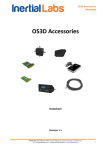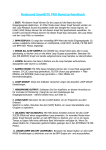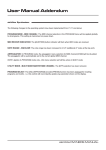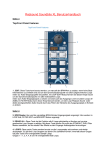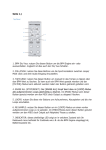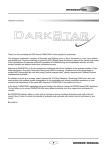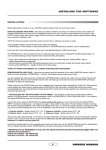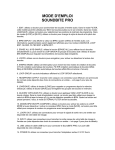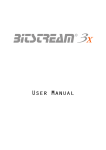Download redsound voyager 1 ownersmanual
Transcript
INTRODUCTION ........................................................ 2 FRONT PANEL ........................................................... 3 REAR PANEL ............................................................... 5 EXT. MIDI SEQUENCER SETTINGS ................ 6 OPERATING CRITERIA ........................................... 6 INPUT LEVEL SETTINGS ...................................... 7 CONNECTIONS - OPTION A ..............................8 CONNECTIONS - OPTION B ..............................9 OPERATION Getting started / Powering Up ........................10 BPM Displays .............................................................11 Selecting the Active Channel .............................11 Controlling The MIDI Clock ..................................12 Run/Pause ..................................................................13 Beat One Re-Set ..................................................... 14 Tap (Stop) .....................................................................14 Cue ...................................................................................16 Beat Tracking Indicator .........................................18 Background Channel ..............................................18 Switching Channels .................................................19 TROUBLESHOOTING /HINTS & TIPS........20 SPECIFICATION ...................................................... 21 1 VOYAGER 1 - CONTENTS INTRODUCTION Thank you for buying the RED VOYAGER 1 Beat Xtractor. The product you have purchased is the essential, creative DJ re-mix product of the decade. Described by DJ magazine's Daniel Duffel as 'The missing link between audio and MIDI', the VOYAGER 1 analyses audio signals from vinyl or CD/ tape and calculates the tempo or 'BPM' of the tracks. The BPM's are displayed but, more importantly, the beat information from one of the channels is used to generate a MIDI Clock signal which runs in synchronisation with the audio track enabling any connected MIDI sequencer/tone module such as **Roland's MC303/ MC505, EMU's Orbit / Planet Phatt, QuasiMidi's latest Rave-o-lution 309 or in fact any computer /sequencer software setup to automatically lock-in and track the tempo of the audio. The VOYAGER 1's intelligent software constantly monitors and corrects the relative audio / MIDI beat synchronisation to keep the beats locked together and also follows any tempo changes in real-time if vinyl/CD deck pitch controls are adjusted. Now, for the first time, the tempo of patterns & songs programmed into your MIDI sequencer can be controlled directly from the audio leaving you free to add or 'tweak' your own MIDI music / percussion parts and produce the ultimate, individual DJ performance. Please read the following sections of this manual carefully to understand the full potential of your VOYAGER 1 Beat Xtractor. Ready for launch! TM REDVOYAGER 1 Beat Xtractor ** Trademarks of E-MU Systems / Roland Corp. Japan / Quasimidi VOYAGER 1 MISSION GUIDE 2 FRONT PANEL 1 2 3 4 5 www.redsound.com RED VOYAGER 1 Beat Xtractor CH 1 BPM CH 2 BPM SELECT CHANNEL 1 PULL OK CHANNEL 2 PUSH BEAT TRACKING - / Down +/ Up Tempo Edit Beat One RUN/PAUSE 6 7 CUE BEAT ONE RE-SET MIDI CLOCK 8 TAP (STOP) 9 10 1 CHANNEL 1 Display The BPM reading of the Channel 1 audio input will be displayed here. 2 CHANNEL 1 Button Press this button to select Channel 1 as the active channel for driving the MIDI Clock output. Also, press and hold to de-activate the beat tracking. 3 BEAT TRACKING Indicator This 3-way indicator shows any internal synchronisation adjustments. 4 CHANNEL 2 Button Press this button to select Channel 2 as the active channel for driving the MIDI Clock output. Also, press and hold to de-activate the beat tracking. 3 VOYAGER 1 - FRONT PANEL FRONT PANEL 5 CHANNEL 2 Display The BPM reading of the Channel 2 audio input will be displayed here. 6 RUN/PAUSE Button Press this button to Run and Pause your MIDI sequencer. 7 CUE Button Press this button to set the 'Cue Paused' and 'Cue Ready' modes - see page16 for further information. 8 BEAT ONE RE-SET Button Press and release this button to re-align the start point (beat1/bar1) of the current pattern or song in your MIDI sequencer with any chosen point in the audio track. 9 MIDI CLOCK Display This 8 indicator display 'rotates' at the detected BPM speed when the VOYAGER 1 is in RUN mode (MIDI Clock running). As the display rotates, the 'Beat One' indicator flashes brighter to show each beat of the bar. The Beat One indicator also flashes at the detected BPM when the VOYAGER 1 is in PAUSE mode. 10 TAP (STOP) Button 'Tap' this button to manually enter a tempo if there is no audio signal present or when the regular patterns and beats in the audio track become unavailable. When used in conjunction with the '- / Down' and '+/ Up' buttons (Tempo Edit mode - LED on) the tempo can be set more accurately in single BPM steps. The MIDI Clock will run at the set BPM. Also, when this button is pressed and held for approx.1 second the MIDI Clock will stop. VOYAGER 1 MISSION GUIDE 4 REAR PANEL 1 2 3 4 5 6 7 www.redsound.com CHANNEL 2 MIDI CLOCK CHANNEL 1 PHONO CD/LINE R R OUT Beat Xtractor ON L L CD/LINE VOYAGER 1 POWER PHONO + 9v DC OFF MADE IN ENGLAND IN OUT IN OUT RED Sound Systems Ltd 8 CAUTION: DO NOT OPEN CASE REFER TO QUALIFIED SERVICE PERSONNEL NO USER SERVICEABLE PARTS INSIDE 9 1 MIDI OUT Connector Use a suitable MIDI cable to connect the MIDI 'IN' of your MIDI sequencer to this connector . 2 CHANNEL 2 Input select switch This selects the Channel 2 input signal level. NOTE: The setting of this switch must always match the input channel on your mixing desk. i.e if 'PHONO' input is selected on the VOYAGER 1 use a 'PHONO' level input on your mixing desk. Nominal input levels - CD/Line 2.0V - Phono 5mV 3 CHANNEL 2 Input connectors Connect the left (L) and right (R) output of the Channel 2 sound source (CD, phono, tape etc.) to these connectors. 4 CHANNEL 1 Input select switch This selects the Channel 1 input signal level - see NOTE at 2 above. 5 CHANNEL 1 Input connectors Connect the left (L) and right (R) output of the Channel 1 sound source (or the mixing desks MASTER outputs (see Option B) to these connectors. 6 DC POWER IN connector Only use the AC/DC adaptor supplied with this product - 'RED PSU'. 7 POWER switch This turns the power on/off. 5 VOYAGER 1 - REAR PANEL MIDI SETTINGS 8 CHANNEL 2 Output connectors Connect the channel 2 audio outputs to a suitable mixing desk input. 9 CHANNEL 1 Output connectors Connect the channel 1 audio outputs to a suitable mixing desk input. EXTERNAL MIDI SEQUENCER SETTINGS Before the VOYAGER 1 can operate correctly you must first ensure that your MIDI sequencer is set to respond to External MIDI Clock commands. Please consult the manufacturers operation manual to make the necessary settings. Here are some typical examples: ROLAND MC-303 In System Settings, set the 'SYNCHRONIZATION SETTING' to 'Slave' mode. E-MU Orbit / Planet Phatt etc. In Master Menu, set 'GLOBAL TEMPO' down below 1 BPM to 'External' mode and set the 'BEATS MODE to 1, 2 or 3. QUASIMIDI RAVE-O-LUTION 309 In the 'EDIT' page press F3 to select 'SYSTEM'. Select page 3 with the 'PAGE' dial. Use the 'EDIT VALUE' wheel to set MIDI SYNC to 'EXT'. OPERATING CRITERIA This product has been designed to operate most effectively with dance music - i.e. music which is based on strong regular beats and patterns. However, as the range of pre-recorded dance material is virtually limitless (and the audio mix of individual tracks unknown) we cannot guarantee the performance of the VOYAGER 1 with every dance track. The VOYAGER 1 may operate unsatisfactorily if the beat information is either unavailable or indefinable within the audio track. Please note this when selecting your audio source material. VOYAGER 1 MISSION GUIDE 6 INPUT LEVELS CD/LINE LEVEL SETTINGS Selecting the correct input level is critical to the performance of the VOYAGER 1. If the incorrect range setting is used you may experience problems with the VOYAGER 1's ability to detect the BPM (due to internal low or overloaded signal levels). The VOYAGER 1 is shipped with it's CD/Line levels preset for 'DJ' type CD players. i.e. those which have a nominal output level of 2V 0dB. If you wish to use the VOYAGER 1 with a Hi-Fi type CD player (or any other player which has a nominal output level between 100 to 350mV) you must first make changes to the jumper links for that channel within the product. 1. Turn off the power and remove all the connectors from the back panel. 2. Turn the product over and remove the 4 screws holding the rear panel. 3. Lift off the rear panel and identify the 8 'jumper' links located on the circuit card behind the rear panel connectors as detailed below. CHANNEL 2 CHANNEL 1 J5 J6 J8 DJ J9 LOW J7 J11 J10 CH 2 DJ LOW J12 CH 1 'DJ' = 1V to 2.5V 'LOW' = 140mV to 350mV 5. To set Channel 1 to 'LOW ' level operation remove the two links J7, J8 and re-fit to J11, J12. To set Channel 2 to 'LOW ' level operation remove the two links J5, J6 and re-fit to J9,J10. Press links firmly into position. 6. Check that no loose parts are left inside the product. 7. Replace the rear panel and refit the 4 screws. 7 VOYAGER 1 - INPUT LEVELS CONNECTIONS - OPTION A 2 channel / 2 x sound source operation SOUND SOURCE 2 SOUND SOURCE 1 VINYL TURNTABLE OR VINYL TURNTABLE OR CD / TAPE etc. CD / TAPE etc. R L R L www.redsound.com CHANNEL 2 MIDI CLOCK CHANNEL 1 PHONO POWER L L CD/LINE CD/LINE R R OUT VOYAGER 1 Beat Xtractor ON PHONO + 9v DC OFF MADE IN ENGLAND IN OUT IN OUT RED Sound Systems Ltd L R L RED PSU R CAUTION: DO NOT OPEN CASE REFER TO QUALIFIED SERVICE PERSONNEL NO USER SERVICEABLE PARTS INSIDE SUITABLE MIDI CABLE TO AC WALL SOCKET AUDIO OUT MIDI IN MIDI SEQUENCER / TONE MODULE MIXING DESK VOYAGER 1 MISSION GUIDE 8 CONNECTIONS - OPTION B Single channel / multiple sound source operation MULTIPLE SOUND SOURCE'S CD / TAPE etc. CD / TAPE etc. VINYL TURNTABLE VINYL TURNTABLE RED PSU MASTER OUTPUT MAIN MIXING DESK USE 'CD/LINE' LEVEL SETTING R ONLY TO AC WALL SOCKET L www.redsound.com CHANNEL 2 MIDI CLOCK CHANNEL 1 PHONO POWER CD/LINE L CD/LINE Beat Xtractor OUT IN OUT RED Sound Systems Ltd R AUDIO OUT MIDI SEQUENCER / TONE MODULE 9 + 9v DC OFF MADE IN ENGLAND IN SUITABLE MIDI CABLE MIDI IN R R OUT VOYAGER 1 ON PHONO L VOYAGER 1 - CONNECTIONS CAUTION: DO NOT OPEN CASE REFER TO QUALIFIED SERVICE PERSONNEL NO USER SERVICEABLE PARTS INSIDE L MIXED AUDIO + MIDI AUDIO TO POWER AMP SUB MIXING DESK OPERATION GETTING STARTED Connect the VOYAGER 1 to your system using either connection OPTION A or B as detailed on pages 8 / 9. If you choose Option B, avoid changing the volume and/or tone controls on the mixing desk during a performance as this will greatly affect the VOYAGER 1's input signal (Example: a Bass tone control turned down could eliminate all the bass drum beat information from the track). Also, a sub-mixer must be used to eliminate any MIDI driven audio feeding back into the VOYAGER 1 from the main mixers MASTER OUTPUT (this would cause the VOYAGER 1 to follow it's own tempo rather than the audio track's). Make sure the correct input signal level(s) have been selected to match your sound source(s) and mixing desk. NOTE: When a channel is not in use (e.g. no physical input/output connections) always set it's level switch to the 'CD/LINE' position (this will avoid any random BPM readings being displayed). EXTREMELY IMPORTANT - When using vinyl record decks as the sound source always check the individual earth lead connections are in good condition and firmly secured to the grounding post on the mixing desk. If the earth lead(s) is broken or disconnected, the resultant low noise hum will not only degrade the audio quality of your system but also greatly affect the BPM detection performance of the VOYAGER 1. POWERING-UP Press the rear panel 'Power' on/off switch to the ON position (in). The software version will be shown briefly on the displays as in the following example: Software version =1.01 CH 1 BPM CH 2 BPM VOYAGER 1 MISSION GUIDE 10 OPERATION Afterwards the displays should look like this: CH 1 BPM CH 2 BPM Three static centre bars indicate a 'no audio beat detected' condition With no audio signal present the centre bars show that both channels are currently inactive. BPM Displays The VOYAGER 1 features two audio input channels, each having a 3 digit BPM display. When a tempo is detected on either input the BPM reading will be shown on the relevant display. NOTE: Although the displayed BPM has a resolution of I BPM, the internal working resolution is much higher, enabling the VOYAGER 1 to track to an accuracy of 0.01 of a BPM. When audio is present on both channels simultaneously, the BPM readings can be used to visually align the tempo's of two separate audio tracks. THE MIDI CLOCK - Selecting The Active Channel Check that the MIDI sequencer is set to respond to external MIDI Clock commands - see page 6. The audio input from channel 1 or 2 can be selected to drive the MIDI clock output. The selected channel is called the 'ACTIVE CHANNEL'. To select Channel 1 as the active channel, press the Channel 1 button. The indicator will light to show Channel 1 is the active channel. To select Channel 2 as the active channel, press the Channel 2 button. The indicator will light to show Channel 2 is the active channel. NOTE : The channel selection process within the VOYAGER 1 will not affect the audio signal fed to the mixing desk in any way. 11 VOYAGER 1 - OPERATION - THE MIDI CLOCK OPERATION THE MIDI CLOCK - Controlling the MIDI Clock With the active channel selected you can run the MIDI Clock. In Example 1 we will assume the following set up using connection OPTION B: CHANNEL 1 Input = Mixer's Master Output with audio track @ 126 BPM CHANNEL 2 Input = No Input - set level switch to CD/Line Select Channel 1 as the active channel and start the audio track playing on the sound source. When the VOYAGER 1 detects the tempo from beat information within the track the Channel 1 display will change from: to... CH 1 BPM The display may briefly show a range of BPM readings as the VOYAGER 1 calculates the exact tempo. When the correct BPM has been locked-in, the 'Beat One' indicator in the 'MIDI CLOCK' display and 'RUN/PAUSE' indicator will flash at the detected BPM speed (126) to indicate 'PAUSE READY' mode. INPUT SIGNAL OVERLOAD DISPLAY If the input levels are setup incorrectly the internal signal may overload (distort). If this occurs, the display will show the following: CH 1 BPM CH 1 BPM CH 1 BPM 3 rising centre bars indicate 'input overload' condition NOTE: the audio track monitored from the mixing desk will NOT sound distorted. The overload display is only used to warn that the signals within the VOYAGER 1 are overloading and that it's performance will be affected. If the overload display comes on, check the settings of the rear panel switch and internal jumpers to ensure they match the sound source. VOYAGER 1 MISSION GUIDE 12 OPERATION RUN/PAUSE Button Select a suitable pattern on your MIDI sequencer. To Run the MIDI sequencer, press the 'RUN/PAUSE' button once. NOTE: To set the initial alignment of the MIDI sequence and audio track, press this button accurately on the desired beat. Any misalignment error at this stage will be automatically corrected during the first few seconds of operation. The 'RUN/PAUSE' indicator will stay on and the 'MIDI CLOCK' display will 'rotate' in synchronisation with the detected BPM to indicate 'RUN' mode. Your MIDI sequencer's pattern should now be playing in synchronisation with the audio track. To Pause the MIDI sequencer at any time, press the 'RUN/PAUSE' button once. The 'MIDI CLOCK' display will stop rotating and the 'RUN/PAUSE' / 'Beat One' indicators will flash to indicate 'PAUSE' mode . The MIDI sequencer's pattern or song will be held at the pause position and will only continue from that point when the 'RUN/PAUSE' button is pressed again. If you want to start the pattern or song from the begining (beat 1/bar1) and not the paused point, press the 'BEAT ONE RE-SET' button before pressing the 'RUN/PAUSE' button again. IMPORTANT NOTE: The VOYAGER 1 has been designed to continue running the MIDI Clock indefinitely at the last detected BPM if the strong regular beats in the audio track become unavailable. This feature allows your MIDI sequencer to fill in parts during quite passages of the audio track without interuption or to continue playing after the track has finished. If the strong regular beats in the audio track become unavailable at any time, the active channel's 3 decimal point indicators will flash continuously as shown: CH 1 BPM 13 3 flashing decimal points indicate 'free-wheeling' condition VOYAGER 1 - OPERATION - RUN/PAUSE BUTTON OPERATION This will occur approx. 5 seconds after the last detected BPM reading was taken to warn that the VOYAGER 1 is now 'free-wheeling' and the BPM display is no longer being updated from the audio track. When the strong regular beats in the audio track return, the VOYAGER 1 will automatically detect the BPM information and make any necessary adjustments, at which time the flashing decimal point indicators will go out to indicate a 'locked-in' condition. BEAT ONE RE-SET Button This button is used to re-align the start point of the MIDI pattern or song (beat1/bar1) with any chosen beat in the audio track. Press the 'RUN/ PAUSE' button to run your MIDI sequencer. Press and hold down the 'BEAT ONE RE-SET' button. The MIDI sequencer will stop and reset to beat1/bar1. When the button is released the MIDI sequencer will restart. This feature allows you to set the relative synchronisation of the audio and MIDI sequencer "on the fly". NOTE: If this button is pressed momentarily, a minimum reset period of 1/4 second will elapse before automatic restart. This allows all MIDI sequencers to respond correctly to the series of MIDI clock commands. TAP (STOP) Button This dual function button allows you to either enter / adjust a tempo by hand (TAP/TEMPO EDIT) or stop the MIDI clock (STOP). The 'TAP' feature can be used to set and run the MIDI Clock in the following conditions: 1. If there is no audio input present and you want to run your MIDI sequencer before starting the audio track. 2. If beat information becomes unavailable and the unit is 'free-wheeling during a quite section of an audio track (intro, middle eight etc.). To enter a tempo when there is no audio input present you can either: VOYAGER 1 MISSION GUIDE 14 OPERATION TAP - (Coarse changes) Use your finger to tap in a tempo on the 'TAP' button. After 3-4 taps the tempo will be shown on the active channel's BPM display. Tempo Edit - (Fine changes) Press the 'TAP' button once. The 'TAP' indicator will come on. - / Down +/ Up Tempo Edit Tap indicator ON indicates 'Tempo Edit' mode CUE BEAT ONE RE-SET TAP (STOP) The VOYAGER 1 is now in 'Tempo Edit' mode. Pressing either the '-/Down' or '+/ Up' button once will bring up the default tempo (120 BPM) on the active channel's display. You can now use the '-/Down' or '+/ Up' buttons to set a tempo anywhere within the range of the VOYAGER 1. If necessary, use the 'RUN/PAUSE' button to check the tempo as you make the adjustments. When you have set the desired BPM, press the 'TAP' button again. The indicator will go out. The 'CUE' and 'BEAT ONE RE-SET' buttons will revert to their normal operation. To make adjusments to a detected BPM when beat information becomes unavailable you can either: TAP - (Coarse changes) Use your finger to tap in your tempo on the 'TAP' button. After 3-4 taps the new tempo will be shown on the active channel's BPM display and the MIDI clock will run at that speed. Tempo Edit - (Fine changes) Press the 'TAP' button once. The 'TAP' indicator will come on. The current detected BPM reading will be displayed. Pressing either the '-/Down' or '+/ Up' buttons will change the displayed BPM and update the MIDI clock speed in real-time. 15 VOYAGER 1 - OPERATION - TAP (STOP) BUTTON OPERATION NOTE: Beat information detected from the audio track will override any BPM changes made with the 'Tempo Edit' function. The manual 'TAP' function can be used to assist the VOYAGER 1's initial BPM detection of more complex rhythm tracks. Tapping along with the tempo of the track can help the software to recognise patterns within the music and so lock-in and adjust the BPM and/or beat tracking. The Stop function is used to stop the MIDI Clock or 'clear' incorrect BPM readings from the active channel. Press and hold down the 'TAP(STOP)' button for approx.1 sec. The BPM readings will be replaced by three centre bars and the 'MIDI CLOCK' display and 'RUN/PAUSE' indicators will go out. CUE Button This button is used to pre-set the VOYAGER 1 to the BPM of an audio track prior to the actual performance. The MIDI sequencer and audio track can then be started simultaneously from any predetermined cue point within the audio track. In Example 2 the VOYAGER 1 is setup using connection Option A: CHANNEL 1 Input = CD player connected with audio track @ 106 BPM CHANNEL 2 Input = Turntable connected with audio track @ 133 BPM Select Channel 2 as the active channel and start the audio track playing on the Channel 2 sound source. NOTE: For the Cue function to operate, the VOYAGER 1 must first be detecting a BPM - i.e. the Cue function will not operate if a 'no audio beat detected' condition exists. The active channel's display will show: CH 2 BPM VOYAGER 1 MISSION GUIDE 16 OPERATION When you are satisfied with the BPM reading, press the 'CUE' button once. The 'CUE', 'RUN/PAUSE' and 'Beat One' indicators will flash to indicate Cue Pause mode. Flashing indicator CUE The VOYAGER 1 is now held in Cue Pause mode and will not respond to any further audio signals which appear on the active channel input. You can now find a suitable cue point on the audio track using the cue facilities on the playback device without activating the VOYAGER 1. NOTE: the Cue function will work most effectively from a strong cue point on the audio track. For the best results, always try to find a cue point fractionally before a well defined bass drum. Once you have set the cue point on the audio playback device, press the 'CUE' button again. The 'CUE' indicator will stay on (stop flashing) to indicate Cue Ready mode. The 'RUN/PAUSE' and 'Beat One' indicators will continue to flash. Cue indicator ON indicates 'Cue Ready'mode CUE The VOYAGER 1 is now waiting for the same audio track to start again. Ensure that you have selected a suitable pattern or song on your MIDI sequencer. Start the audio track playback on the Channel 2 sound source. The MIDI sequencer will immediately run in synchronisation with the audio track. The MIDI Clock display will start to rotate and the 'CUE' indicator will go out. The 'RUN/PAUSE' indicator and BPM display will stay on to indicate 'RUN' mode. To cancel either 'Cue Pause' or 'Cue Ready' modes at any time simply use the 'STOP' function - press and hold the 'TAP(STOP)' button for 1 second. 17 VOYAGER 1 - OPERATION - CUE BUTTON OPERATION BEAT TRACKING Indicator This indicator shows any beat synchronisation adjustments between the audio track and MIDI sequence. The VOYAGER 1 constantly analyses the accuracy of the relative beat positions and will either 'PULL' or 'PUSH' the MIDI clock output to maintain synchronisation. When the audio and MIDI are synchronised the 'OK' indicator will light. PULL OK PUSH BEAT TRACKING If the MIDI clock is ahead of the audio, the 'PULL' indicator will light. PULL OK PUSH BEAT TRACKING If the MIDI clock is behind the audio, the 'PUSH' indicator will light. PULL OK PUSH BEAT TRACKING The VOYAGER 1's automatic beat tracking software can be temporarily disengaged. In 'RUN' mode, press and hold down the active channel's button. The indicator will flash to show a 'tracking disengaged' condition. CH 1 BPM CH 2 BPM SELECT CHANNEL 1 PULL OK PUSH CHANNEL 2 BEAT TRACKING Flashing indicates 'tracking disengaged' condition When released, the beat tracking will automatically take over again. NOTE: This feature allows the VOYAGER 1 to ignore any erratic, offbeat material present in some sections of the audio track which would otherwise cause unnecessary adjustments and disrupt the synchronisation. VOYAGER 1 MISSION GUIDE 18 OPERATION BACKGROUND CHANNEL OPERATION As previously explained in 'Selecting The Active Channel' on page 11, only one channel at a time can be selected to drive the MIDI Clock i.e. the 'ACTIVE CHANNEL'. The channel which is NOT selected at any time is called the 'BACKGROUND CHANNEL' (in example 2 this would be Channel 1). The background channel's function is solely to detect and display current BPM readings from the connected audio source. It will only display a BPM reading if it detects a strong regular beat in the audio track. If the beats become unavailable at any time, the background channel's display will flash three times and change from: 3 flashes indicates 'BPM lost' mode to... CH 1 BPM When a valid BPM reading is detected, the display will again show: CH 1 BPM SWITCHING BETWEEN CHANNELS You can switch the 'ACTIVE CHANNEL' at any time, providing both channels are detecting a BPM reading. If Channel 1 and 2 are receiving audio tracks with different BPM values, the MIDI Clock will 'jump' to the new tempo. Using Example 2's set-up, the 'ACTIVE CHANNEL' is currently Channel 2. CH 1 BPM CH 2 BPM SELECT CHANNEL 1 19 CHANNEL 2 VOYAGER 1 - SWITCHING BETWEEN CHANNELS Active Channel TROUBLESHOOTING The MIDI Clock output is running at 133 BPM. Press the 'CHANNEL 1' button. CH 1 BPM Active Channel CH 2 BPM SELECT CHANNEL 2 CHANNEL 1 The MIDI Clock will now run at 106 BPM. TROUBLESHOOTING Erratic/Poor performance * Check input level settings match the sound source's output level. * Low output level from sound source. * Poor quality phono leads/bad earth connection. * Monitored channel not selected as the active channel. * Vinyl deck - earth cable not connected to mixing desk and/or damaged. * Vinyl deck - worn cartridge or stylus (low output). * MIDI driven audio being fed back into VOYAGER 1 input ( Connection option - B ). HINTS & TIPS Tempo Changes * Always make slow changes when adjusting the sound source pitch control. * Never make tempo changes during quite passages (when beat information is unavailable) as the VOYAGER 1 will lose synchronisation. Synchronisation * Use the 'Tempo Edit' feature to manually adjust any synchronisation error during quite passages (when beat information is unavailable). * Disengage the beat tracking prior to breaks which contain erratic beats. VOYAGER 1 MISSION GUIDE 20 SPECIFICATION SPECIFICATION Performance BPM Range = 90 to 180 BPM Lock-in time = 2 to 4 sec's (from introduction of readable beat information) Input Levels CD/ Line 'DJ' = 1V to 2.5V CD/ Line 'LOW' = 140mV to 350mV Phono = 1.5 to 15 mV Level setting = AGC (automatic gain control) circuitry Displays 2 x 7 Segments, 3 character (LED) MIDI Clock rotating display (8xLEDs), Beat Tracking display (3xLEDs) Controls Channel 1 select, Channel 2 select, Run/Pause, Cue, Beat One Re-Set, Tap(Stop) MIDI Implementation System Real Time / Clock commands = Transmitted Connectors Channel 1 Input/Output, Channel 2 Input/Output, MIDI Clock Out, AC adaptor Power Supply 9vDC, 250mA (RED PSU) Dimensions/Weight 180(W)x132(D)x50(H)mm, 1.65 Kg NOTE: channel 1-2 crosstalk occurs if the VOYAGER 1's power is turned off with the sound sources still connected. (Audible on the mixing desk output - i.e. Low level audio from channel 1 will be heard on channel 2 and vice-versa) 21 VOYAGER 1 - SPECIFICATION For the USA FEDERAL COMMUNICATIONS COMMISSION RADIO FREQUENCY INTERFERENCE STATEMENT This equipment has been tested and found to comply with the limits listed for a Class B digital device, pursuant to Part 15 of the FCC Rules. These limits are designed to provide reasonable protection against harmful interference in a residential installation. This equipment generates, uses, and can radiate radio frequency energy and, if not installed and used in accordance with the instructions, may cause harmful interference to radio communications. However, there is no guarantee that interference will not occur in a particular installation. If this equipment does cause harmful interference to radio or television reception, which can be determined by turning the equipment off and on, the user is encouraged to try to correct the interference by one or more of the following measures: - Reorient or relocate the receiving antenna. - Increase the separation between the equipment and receiver. - Connect the equipment into an outlet on a circuit different from that to which the receiver is connected. - Consult the dealer or an experienced radio/TV technician for help. Unauthorized changes or modifications to this system can void the users authority to operate this equipment. This equipment requires shielded interface cables in order to meet FCC class B limit. For Europe This product complies with the requirements of European Directive 89/336/EEC For Canada CLASS B NOTICE This digital apparatus does not exceed the Class B limits for radio noise emissions set out in the Radio Interference Regulations of the Canadian Department of Communications. CLASSE B AVIS Cet appareil numerique ne depasse pas les limites de la Classe B au niveau des emissions de bruits radioelectriques fixes dans le Reglement des signaux parasites par le ministere Canadien des Communications. * Specifiction and / or appearance subject to change without prior notice due to product improvement. Copyright / Software Copyright / Design Right RED Sound Systems Ltd. 1997 Printed in England RED TM MUSIC,MIND,BODY&SOUL RED Sound Systems Ltd., Chancery Court Business Centre Lincolns Inn, Lincoln Road, High Wycombe, Bucks. HP12 3RE England Phone : +44 (0)1494 429321 Fax : +44 (0)1494 446321 www.redsound.com
























